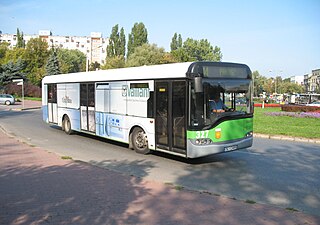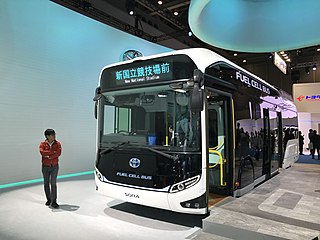 W
WAn electric bus is a bus that is powered by electricity.
 W
WThe Alexander Dennis Enviro200 MMC is a single-decker city bus produced by Alexander Dennis since 2014, as the successor to the Enviro200 midibus and Enviro300 full-size bus. The first Enviro200 MMCs entered service with National Express West Midlands in 2015. Notably, Enviro200 MMCs have been modified by Fusion Processing to be used as the basis for the first driverless bus trials in the United Kingdom.
 W
WThe Alexander Dennis Enviro400 MMC is a low-floor double-decker bus produced by the British bus manufacturer Alexander Dennis since 2014, replacing the Alexander Dennis Enviro400. The Enviro400 MMC is produced at Alexander Dennis' Falkirk and Scarborough factories in the United Kingdom.
 W
WA capacitor electric vehicle is a vehicle that uses supercapacitors to store electricity.
 W
WDancer Bus is an electric bus designed and produced by Vėjo Projektai UAB in Klaipėda, Lithuania. The electric bus is manufactured of composite materials, including recycled PET bottles. The vehicle is 12 metres (39 ft) long, equipped ZF electric drive. In-wheel traction motors are currently in development. Fully charged bus can ride a distance of up to 90 kilometres (56 mi) source. The lithium-titanate battery fully charges in less than 10 minutes. The capacity is 93 passengers with 32 seats and one space for a wheelchair. The bus is certified in the European Union. In April 2020, two buses were purchased by the Klaipėda City Municipality to be used for public transportation.
 W
WThere are 577 electric buses operating in Moscow. This is the largest electric bus fleet in Europe ahead of London's fleet. As of October 2020, electric buses serve 36 routes and since the beginning of their work, they have carried over 55 million passengers and covered more than 22 million kilometers on the roads of Moscow.
 W
WGépébus is a trademarked private sector brand name for electric autobuses made by Power Vehicle Innovation for use in mass public transportation.
 W
WA gyrobus is an electric bus that uses flywheel energy storage, not overhead wires like a trolleybus. The name comes from the Greek language term for flywheel, gyros. While there are no gyrobuses currently in use commercially, development in this area continues.
 W
WKamAZ-6282 is the urban large class low-floor electric bus codeveloped by NefAZ and KamAZ. Mass production of this model began in 2018.
 W
WThe LiAZ-6274 is the urban large class low-floor electric bus produced by the Likinsk Bus Plant. The first fully low-floor electric bus produced in Russia. Designed on the basis of the low-floor bus LiAZ-5292 that mass-produced since 2004. Designed for large cities with intensive passenger traffic. Mass production of this model began in September 2018.
 W
WThe Optare MetroCity is an integral midibus manufactured by Optare since 2013. Originally aimed at the London market, the MetroCity is based on the existing Optare Versa, which continues to be produced separately. In the UK market, longer variants of the MetroCity have replaced the Optare Tempo SR. As at August 2018, over 250 had been built.
 W
WA pantograph is an apparatus mounted on the roof of an electric train, tram, or electric bus to collect power through contact with an overhead line.. The pantograph is a common type of current collector. Typically, a single or double wire is used, with the return current running through the rails. The term stems from the resemblance of some styles to the mechanical pantographs used for copying handwriting and drawings.
 W
WA solar bus or solar-charged bus is a bus that is powered exclusively or mainly by solar energy. Solar-powered bus service is referred to as a solar bus service. The use of the term "solar bus" normally implies that solar energy is used not only for powering electric equipment on the bus, but also for the propulsion of the vehicle.
 W
WSolaris Urbino is a series of low-floor buses and low-entry doorway intercity buses, powered by diesel drive engines and alternative fuel, produced by the Polish company Solaris Bus & Coach in Bolechowo near Poznań in Poland. Currently produced models are of the fourth generation, and by 2019 the production will start for the fifth.
 W
WThe Toyota Sora is a transit bus with an electric motor powered by hydrogen fuel cells produced by Toyota, developed in cooperation with Hino Motors. The bus uses components originally developed for the Toyota Mirai, a mid-size fuel cell sedan. The name Sora is an abbreviation of the words Sky, Ocean, River and Air and refers to the water cycle.
 W
WA trolleybus is an electric bus that draws power from dual overhead wires using spring-loaded trolley poles. Two wires, and two trolley poles, are required to complete the electrical circuit. This differs from a tram or streetcar, which normally uses the track as the return path, needing only one wire and one pole. They are also distinct from other kinds of electric buses, which usually rely on batteries. Power is most commonly supplied as 600-volt direct current, but there are exceptions.
 W
WThe Wright StreetAir is a low-floor single-decker electric bus design built by Wrightbus in Ballymena, Northern Ireland since 2017. An integral product based on a single-deck variant of the Wright StreetDeck chassis, the StreetAir replaces the Wright Electrocity in Wrightbus' product range.